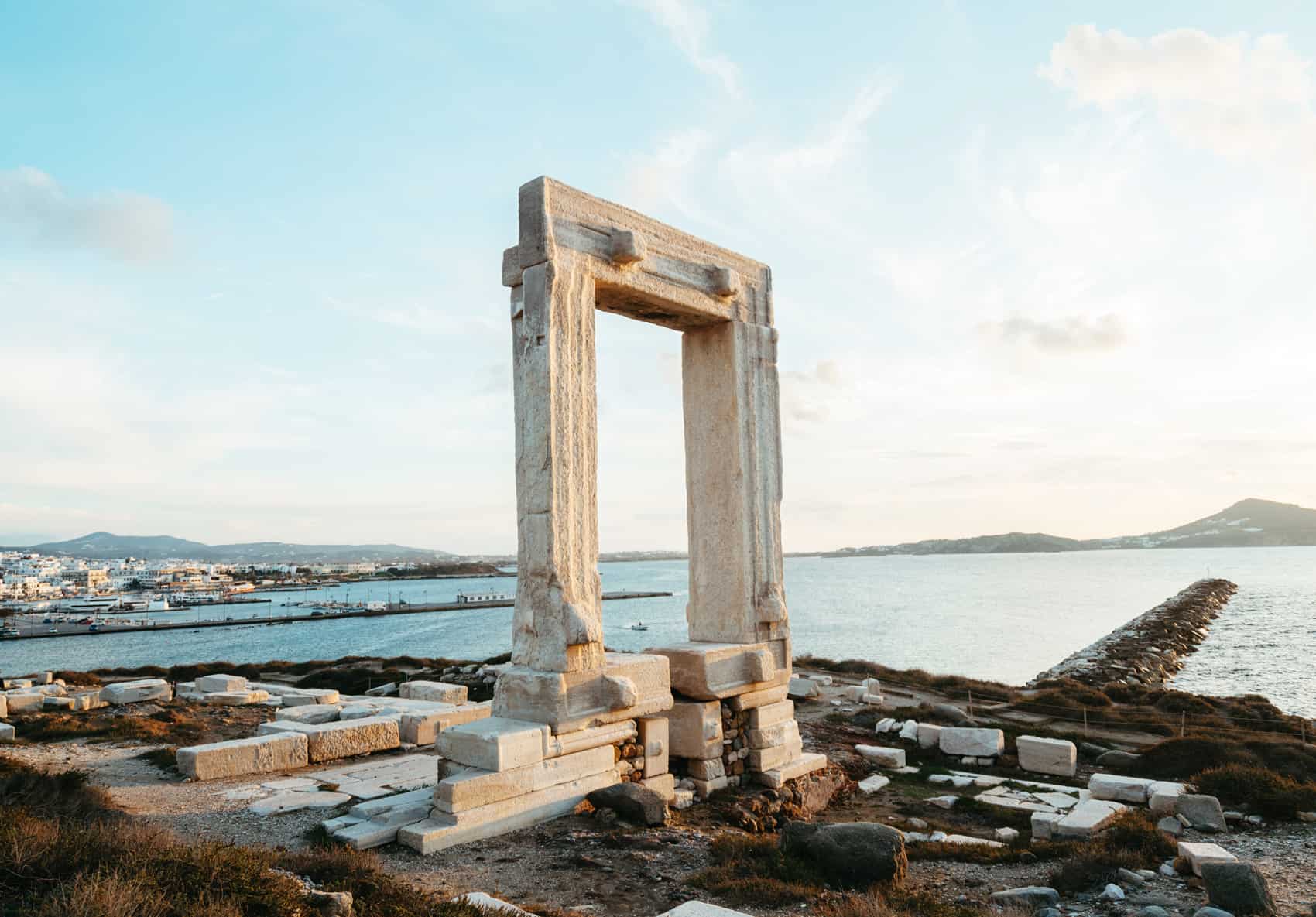Portara in Naxos: How to Visit the Temple of Apollo
Anyone who’s even considering visiting the Greek Islands has probably seen a few photos of Portara in Naxos (a.k.a. The Temple of Apollo).
It’s one of the most well-known historical monuments in all of Greece, and while it’s definitely worth the hype, we also loved about it was how accessible it was from Naxos town.
It was so close to our apartment, which meant we got to visit a few different times. If we weren’t out exploring other monuments across the island, we spent nearly every sunset there. We loved learning about the cultural/religious history of Portara and the archaeology of the temple.
In this post, we’ll share everything you should know about the Portara of Naxos before you go, from the fascinating history to location info, entrance fees, and tips for visiting yourself!

The Portara of Naxos
The Portara of Naxos is the most iconic attraction in Naxos, and it’s pretty obvious why once you know that you’re looking at something built over 2000 years ago!
We still remember standing on top of the ferry as it pulled into Naxos Port and getting so excited that we almost hiked up to it with our suitcase!
It’s breathtaking. Every day, hundreds of people walk up the hill from Naxos Port to see the half-finished Temple of Apollo up close and take in the view of the deep-blue ocean against the whitewashed village.
But the temple is much more than a cool viewpoint and place to add to your Naxos Itinerary. It’s a window into Naxos’ ancient history, architecture, and civilization, which was far ahead of its time.
History & Significance
‘Portara’ translates to “great door” in Greek, and it’s pretty clear why it’s named that when you see what remains of the unfinished temple.
But it’s also called the ‘Temple of Apollo’ since many believe that the structure was dedicated to Apollo, the Greek god of music, harmony, and light.
Although it was never even close to finished.
Over the centuries since it was abandoned, the monument has been used as a marble quarry, with its marble blocks repurposed in several churches in Naxos Town. The marble here was also used in a couple of medieval mansions and fortifications for the Venetian Castro in the heart of Naxos Town.
This rich historical and mythological backdrop, coupled with the architectural wonders of the Portara, makes it the most impressive historical site in Naxos.

When was Portara Built?
Construction of the Portara dates back to the 6th-7th century BCE. It was initiated by the tyrant Lygdamis, who ruled Naxos from 545 to 524 BC.
At this time, Naxos was one of the most prosperous islands in the Mediterranean (particularly because of its prized Naxian marble and prime location among other islands in the Aegean.
In this ancient world, the island was a major trade center for commerce and art, and its location between modern-day Greece and Turkey gave it strategic military power.
Architectural Significance
The Portara is a massive marble doorway that stands over 6 meters high and 3.5 meters wide. It’s made from just 4 blocks of marble, each weighing over 20 tons!
Archaeological evidence indicates that the Temple, as originally planned, would have centered around a cella with a colonnade of two rows with four columns in each row. This is the same architectural plan as the Acropolis in Athens or the entrance to the Pantheon in Rome.
All of the marble was sourced locally from Naxos, which makes sense since both Naxos and Paros were known for having extremely high-quality marble.
Lygdamis’ goal was to construct a grand temple that would surpass even the temples of Zeus in Athens and Hera in Samos. You can tell because the intended size of the temple was at least 59 meters long and 28 meters wide!
Portara was just supposed to be the doorway, and forms part of the Temple’s naiskos, although it was obviously never completed. The reasons for the Temple’s abandonment are still a matter of historical speculation, but it probably had to do with Lygdamis’s overthrow in 524 BC.

Cultural and Religious Importance
Apollo was a deity of immense importance in Greek mythology, symbolizing order, beauty, and reason.
The temple faces directly toward Delos, which is Apollo’s sacred birthplace, and this is part of the evidence that leads scholars to believe the temple was truly built in the name of Apollo.
However, the site also intertwines with the story of Ariadne, who, after being abandoned by Theseus, was said to have married Dionysus on Naxos. So, some people argue that the temple was actually built to honor Dionysus.
Visiting Today: What to Expect
Visiting the iconic gateway to what was supposed to be the Temple of Apollo on Naxos is one of the best parts about visiting Naxos. It’s a tangible way to take a step back into the post, but you hardly have to go out of your way to see it!
Here is everything you should know about visiting today, from the location of the temple to getting there, opening hours, entrance fees, and tips for making the most of your visit!
Where is the Temple of Apollo?
The Temple of Apollo is at the edge of Naxos Town (Chora), right next to the Port of Naxos. We saw it from a few kilometers offshore while taking the ferry from Paros to Naxos.
You can also see it from most cafes and restaurants along the Aegean Sea.
Essential Information & Travel Tips
If you’re hoping to visit the Temple of Apollo while spending a few days in Naxos, then there are some important things you should know before you go!
Entrance Fee – None. It’s completely free!
Opening Hours – 24 Hours
Best Time To Visit – Sunset
We think it’s really cool that Naxos keeps the open-air ruins totally free and accessible for visitors. People can explore the site freely and soak in the history and panoramic views of Naxos.
The only thing that’s kind of unfortunate about visiting Portara in Naxos is that it gets SO crowded, especially in the summer months around sunset.
If you’re hoping to escape the crowds, then go first thing in the morning (before 9:00 AM), or visit Naxos during shoulder season.

How to Get There
You can get to the Portara in Naxos by a short walk from Chora. Just follow the main boardwalk along the port, and it will eventually narrow into a small causeway that leads out to the small peninsula where you’ll find the temple.
You can see the temple the entire way, so it’s really not complicated to get here.
There are some cafes and places to grab a snack at the edge of the causeway.
It’s only a 5-minute walk across the causeway and then another 5 minutes to the top of the hill, where you can see the towering gate.
The hike is not hard, but it does require about 75 steps to reach the top! The area around the Portara is also pretty easy to navigate once you reach the top of the hill. Any shoes or sandals that have decent traction should be fine, but we definitely don’t recommend heels and flip-flops!
Note: If the ocean is really choppy, waves start crashing near the path, making it a bit slippery.
Parking near Portara
If you’ll be walking from your hotel in Naxos Town, then there’s no need to worry about parking, but for those staying elsewhere in Naxos and taking their rental car to Chora, there are a couple of options.
You can’t really drive right up to the Temple of Apollo, but the closest parking areas are:
- Municipality Parking Lot is a very small, free parking lot. It’s the closest parking area to Portara but is almost always full. Even when there is space, it’s a tight fit, so you’ll probably only find a spot here if you’re planning to rent a scooter in Naxos.
- Naxos Municipality Parking is the largest Lot in Naxos Town and your best chance of finding an open spot during high season. It’s also completely free!
- Naxos Center Parking is where we parked the entire time in Naxos. It was really close to our hotel, and it was easy to find a spot (in shoulder season). Also free 🙂

Best Time to Visit
The best time to visit the Portara is either early in the morning or late in the afternoon towards sunset. If you come first thing in the morning, you’ll likely have the monument to yourself, but it’s not the greatest time of day for photography.
But we got our most impressive photos and views of the Temple of Apollo around sunset.
You just need to be ready to navigate the crowds. Even if it’s crowded, the Portara is still worth seeing, but we just want to be transparent so you don’t come with expectations of peace and quiet.
The Bottom Line
The history behind the Portara of Naxos is fascinating, but even apart from the history, it’s a beautiful monument and offers one of the best viewpoints in Naxos.
We hope that learning more about the history of the Temple of Apollo will help you appreciate the monument more when you visit!
Be sure to check out a few of the stunning beaches in Naxos on your trip, and if you’re struggling to know which area of the island is best, we’ll tell more you about each neighborhood in Naxos here!







